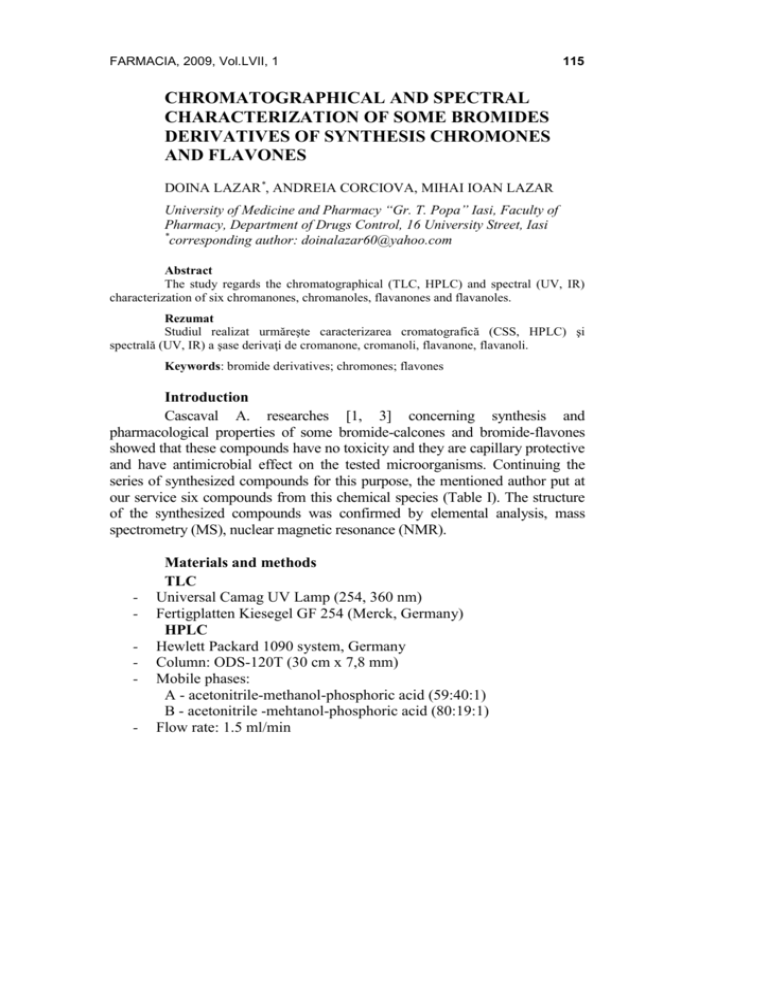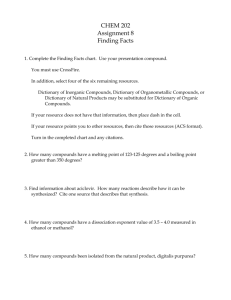chromatographical and spectral characterization of
advertisement

FARMACIA, 2009, Vol.LVII, 1 115 CHROMATOGRAPHICAL AND SPECTRAL CHARACTERIZATION OF SOME BROMIDES DERIVATIVES OF SYNTHESIS CHROMONES AND FLAVONES DOINA LAZAR*, ANDREIA CORCIOVA, MIHAI IOAN LAZAR University of Medicine and Pharmacy “Gr. T. Popa” Iasi, Faculty of Pharmacy, Department of Drugs Control, 16 University Street, Iasi * corresponding author: doinalazar60@yahoo.com Abstract The study regards the chromatographical (TLC, HPLC) and spectral (UV, IR) characterization of six chromanones, chromanoles, flavanones and flavanoles. Rezumat Studiul realizat urmăreşte caracterizarea cromatografică (CSS, HPLC) şi spectrală (UV, IR) a şase derivaţi de cromanone, cromanoli, flavanone, flavanoli. Keywords: bromide derivatives; chromones; flavones Introduction Cascaval A. researches [1, 3] concerning synthesis and pharmacological properties of some bromide-calcones and bromide-flavones showed that these compounds have no toxicity and they are capillary protective and have antimicrobial effect on the tested microorganisms. Continuing the series of synthesized compounds for this purpose, the mentioned author put at our service six compounds from this chemical species (Table I). The structure of the synthesized compounds was confirmed by elemental analysis, mass spectrometry (MS), nuclear magnetic resonance (NMR). - - Materials and methods TLC Universal Camag UV Lamp (254, 360 nm) Fertigplatten Kiesegel GF 254 (Merck, Germany) HPLC Hewlett Packard 1090 system, Germany Column: ODS-120T (30 cm x 7,8 mm) Mobile phases: A - acetonitrile-methanol-phosphoric acid (59:40:1) B - acetonitrile -mehtanol-phosphoric acid (80:19:1) Flow rate: 1.5 ml/min 116 FARMACIA, 2009, Vol.LVII, 1 No. UV-Vis spectroscopy UV-VIS spectrophotometer Jasco V-530 Solvents: chloroform, acrylonitrile, DMSO IR spectroscopy Spekord 100 M spectrophotometer Potassium bromide Structures R1 Table I Structures of compounds R2 1 2 3 4 CH3 5 CH3 6 CH3 117 FARMACIA, 2009, Vol.LVII, 1 1: 6,8-dibromo-3,3-bis –[(morpholin-4-yl)-methyl]-4-chromanone 2: 6,8-dibromo-3,3-bis-[(piperidin-1-yl)-methyl]-4-chromanone 3: 6,8-dibromo-3,3-bis-[(piperidin-1-yl)-methyl]-4-chromanol 4: 6-bromo-3-methyl-3-(piperidin-1-yl)-4-chromanol 5: 6-bromo-3-methyl-3-(piperidin-1-yl)-flavonone 6: 6-bromo-3-methyl-3-(piperidin-1-yl)-flavanol Results and discussion TLC analysis Solvents systems: A. acetonitrile: water: formic acid (25:4:2) (v/v/v) B. benzene: acetonitrile (3:1) (v/v) C. chloroform: acetonitrile: acetic acid (6:3:1) (v/v/v) The six compounds analyzed by TLC on thin Kieselgel GF254 layer, presented Rf x100 values as shown in Table II. Compound 1 2 3 4 5 6 Table II Rf values for 1-6 compounds Rf x 100 A B C 67 55 70 70 70 40 87 67 35 34 15 40 79 58 23 54 59 68 HPLC analysis The analyzed compounds were dissolved in acetonitrile, the solutions having a concentration of 10-5 g%. For analysis it was injected 5 µl of each sample. This method was chosen to prove the chemical functions that defined this chemical species. Table III presented the values of retention time for the analyzed compounds. Table III Retention time for 1-6 compounds Compound Retention time (min) 1 2 3 4 5 6 8.90 10.00 11.90 13.00 4.00 7.00 118 FARMACIA, 2009, Vol.LVII, 1 UV spectroscopy The analyzed compounds were characterized by the insolubility in water and the solubility in acetone, which can’t be used as a solvent in UV domain. The analyses were performed in chloroform, acrylonitrile, DMSO, using 10-4 mol/l solutions. In Table IV are presented the wavelengths λ (nm) for the main peaks. Table IV Wavelengths λ (nm) for the main peaks of 1-6 compounds Compound 1 2 3 4 5 6 λ max (nm) 225, 275 230, 280 234, 273 235, 290 295 298 IR spectroscopy The six compounds were analyzed by dispersion in potassium bromide (disks) with a concentration 0.1% and the spectra can confirm the structure of these compounds by recovering the main bounds and chemical functions in maximum of absorption. The characteristic infrared absorption frequencies are shown in Table V. Table V Characteristic infrared absorption frequencies for compounds 1-6 Wavelength (cm-1) 1: 2860, 1680, 1586, 1424, 1264, 1184, 1104, 1012, 972, 864, 576, 512 2: 2952, 2784, 1680, 1568, 1424, 1248, 1100, 580, 528, 400, 382, 292 3: 2952, 2792, 1424, 1328, 1232, 1200, 1168, 1124, 1008, 752, 592, 560, 504 4: 3208, 2952, 1472, 1296, 1248, 1216, 1168, 1104, 1028, 818, 652, 560, 512, 336, 288 5: 2928, 2800, 1728, 1600, 1456, 1376, 1264, 1216, 1176, 1136, 976, 896, 704, 656, 448, 304 6: 3008, 2825, 1472, 1232, 1176, 1136, 1032, 972, 928, 832, 784, 712, 656, 592, 528, 496, 324 Comparing IR spectra of all compounds we detected the principal chemical bounds from chromones and flavones structure, by finding frequencies around the classic values caused by the inorganic substitutes on A nucleus. These frequencies are: 3050, 3060 (aromatic CH), 3494, 3359 (OH), 2956, 2924, 2850 (CH), 1660, 1661 (CO), 1640, 1625 (C=C, Ar), 3370 NH etc. FARMACIA, 2009, Vol.LVII, 1 - - - 1. 2. 3. 119 Conclusions The synthesized chromones and flavones derivatives are in good purity state and can be chromatographic and spectral characterized There were found HPLC and TLC suited chromatographic systems for their identification and there were settled the bases for the elaboration of some quantitative method The analyzed compounds presented specific absorbances in UV and the maximum of absorption can be used for quantitative determination IR spectra performed in potassium bromide can be used to characterize and to differentiate the carbonyl compounds from the alcoholic compounds. References Cascaval A., 2-hydroxyketones.XIV: A facile one step synthesis of 3, 3, 6, 8tetrasubstituted flavanones, Synthesis, 1984, 3, 277-278 Lazar M.I., Lazar D., Diaconu E., Cascaval A., Huhurez G., Chromatographic and UV-Vis and IR spectral methods for qualitative and quantitative analysis of some synthetic brome-flavones derivatives, J. Pharm. Biomed. Anal.,1999, 20, 573-577 Sandulache A., Cascaval A., Toniutti N., Giumanini A.G., New flavones by a novel synthetic route, Tetrahedron, 1997, 53, 9813-9822 Manuscript received: 02.06.2008






